Summarizing a research article requires a proper balance between comprehension and conciseness. One must remember to highlight the main points to grasp the research concept with a summary. Summarization tools in this advanced AI generation can rapidly outline vast data into simple, concise text. With the knowledge of how to summarize a research article using AI tools, individuals eliminate the need to manually examine lengthy text.
AI-powered summarization tools offer consistency and objectivity in summarizing articles, speeding up professional researchers' analysis work. This comprehensive guide will help you understand the top AI assistants you could use to summarize your research articles.
Part 1. Key Elements of a Research Article
Apart from understanding the importance of adapting to AI research article summarization tools, being aware of an article's essential components is crucial. A complete research paper in the form of APA style typically contains the following key elements:
- Title and Abstract: The title section communicates the topic and scope of the paper, whereas the abstract gives the reader a brief overview of what the article is discussing. This crucial part acts as an accurate research article summary for readers to determine the article's relevance. Together, the title and abstract help the reader decide whether to continue reading the research article.
- Introduction: This section sets the ground by exploring the topic, the significance of the study, and the gaps in existing publications. Using the introduction, writers can outline the research questions or hypotheses the study aims to address. By the end of the section, the readers should be fully aware of the study’s objective and scope.
- Methods: In the methods section, the writer must include details of how the research was performed. Information that needs to be included are the population sample, data collection methods, materials used, and the study procedure. This section should be sufficiently detailed to ensure transparency and reliability.
- Results: The results section presents the study's data and findings. It can include any sort of visual interpretation of the research, such as graphs, tables, or statistical figures. This section focuses on the clarity of facts and figures based on what was collected through research.
- Discussion: Researchers can include a summary of the study's results in the discussion section. This section also includes limitations and directions for future research. Writers can explain their theoretical frameworks in this section to give readers a clear understanding of the research.
- Conclusion: The conclusion provides a summary of the entire article's main findings and their implications. Writers can ensure that the readers are left with a clear understanding of the study's overall contributions and potential impact. To ease the process, this section can be written by using efficient AI summarizers for research articles.
Part 2. Steps to Manually Summarize a Research Article
Moving on, manually summarizing an article deepens your understanding of the content, enabling you to engage more critically with the study. Let’s discuss the steps to be taken so you know how to summarize a research article manually:
Step 1. Read Thoroughly
To understand the research article and write a concise summary, it is essential that you read it thoroughly. Make sure that you read the entire article by paying close attention to each section. To retain information for later reference, you can take notes of significant sections. This comprehensive reading step will help you grasp the main points, arguments, and findings of the study.
Step 2. Highlight Key Points
Identifying important sections and data is critical in summarizing a research article. As you review the content, highlight or underline key points, such as the research question, hypotheses, methodology, significant results, and major conclusions. By highlighting key elements, you create a roadmap to guide you in crafting accurate research article summaries. Therefore, this process ensures that you capture the essence of the research without overlooking essential details.
Step 3. Write a Summary
Start with a brief introduction that outlines the research topic and its significance and continue with a concise summary of the methods. Cover the main findings focusing on the most significant results and conclude with the implications of the study and any potential limitations. A well-written summary should allow readers to understand the study's purpose, methods, results, and implications without needing to read the full article.
Part 3. Using Afirstsoft PDF to Summarize Research Articles
Summarizing a research article manually proves time-consuming, so the utility of AI has brought major advancements. The adaptability of AI PDF summarization tools such as the Afirstsoft PDF came in line. This software has a comprehensive set of PDF editing tools that provide uninterrupted PDF reading and organizing experiences.
Through the intelligent AI models in this software, users can attain efficient AI summarizers for research articles with a single click. It doesn't impose any character limitations and provides accurate summaries while understanding the nuances and technical terms in the article.
After obtaining a summary of your research article, you can refine the documents with annotation and other tools. Thus, without further delay, review this guide and get ready to read multiple research articles in a shorter period.
Step 1. Open the Research Article in Afirstsoft PDF
Visit the Afirstsoft PDF’s official site and download its latest version to start the process. Launch its main interface upon successfully downloading and tap the "Open" icon on the left side to import the research article.
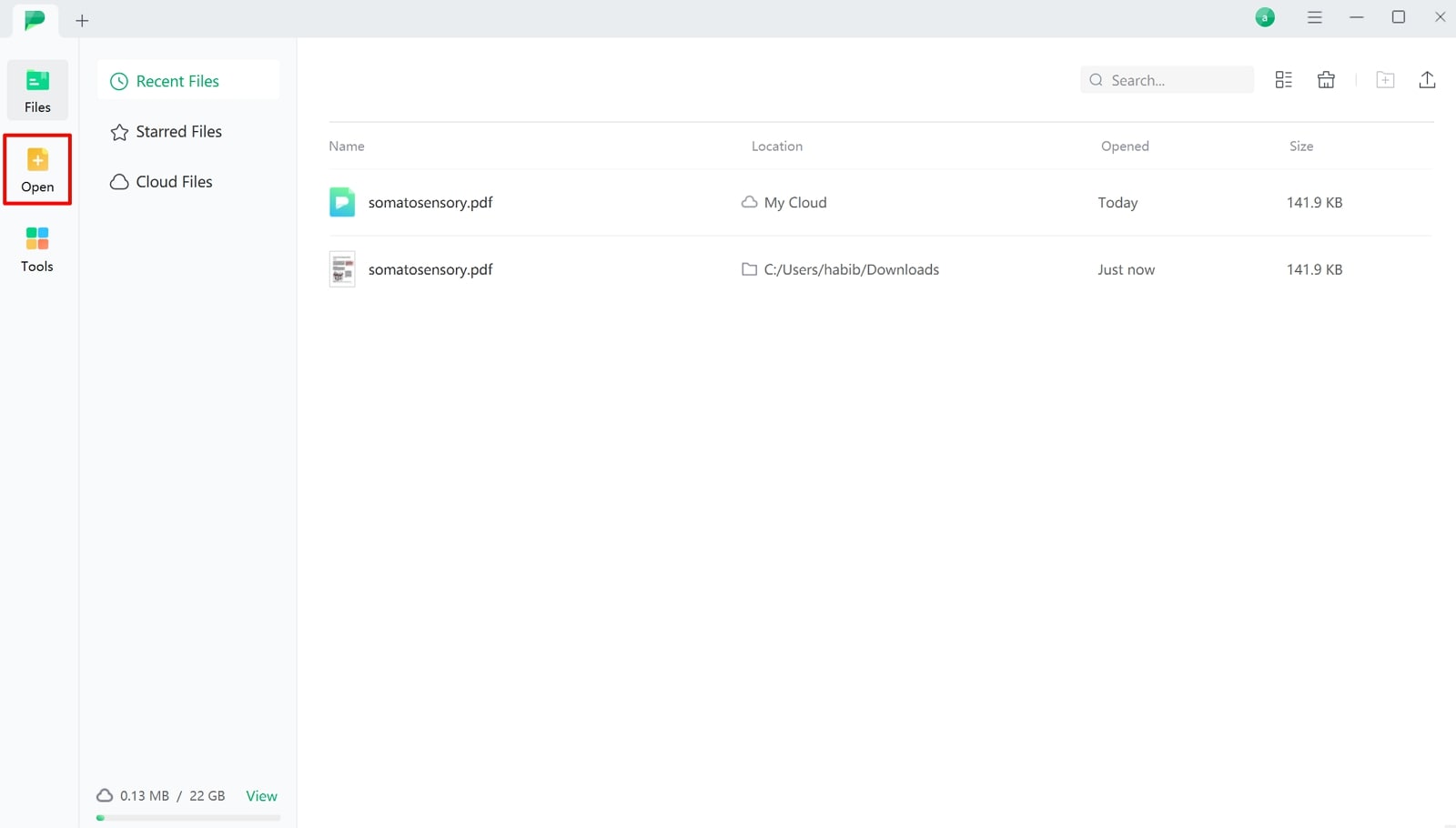
Step 2. Explore and Use the Afirstsoft AI PDF Summary
As you have imported your article, approach the “Afirstsoft AI” option at the right side of the top bar. Click on it and find a panel on the right side to generate the summary with the “Start” button.
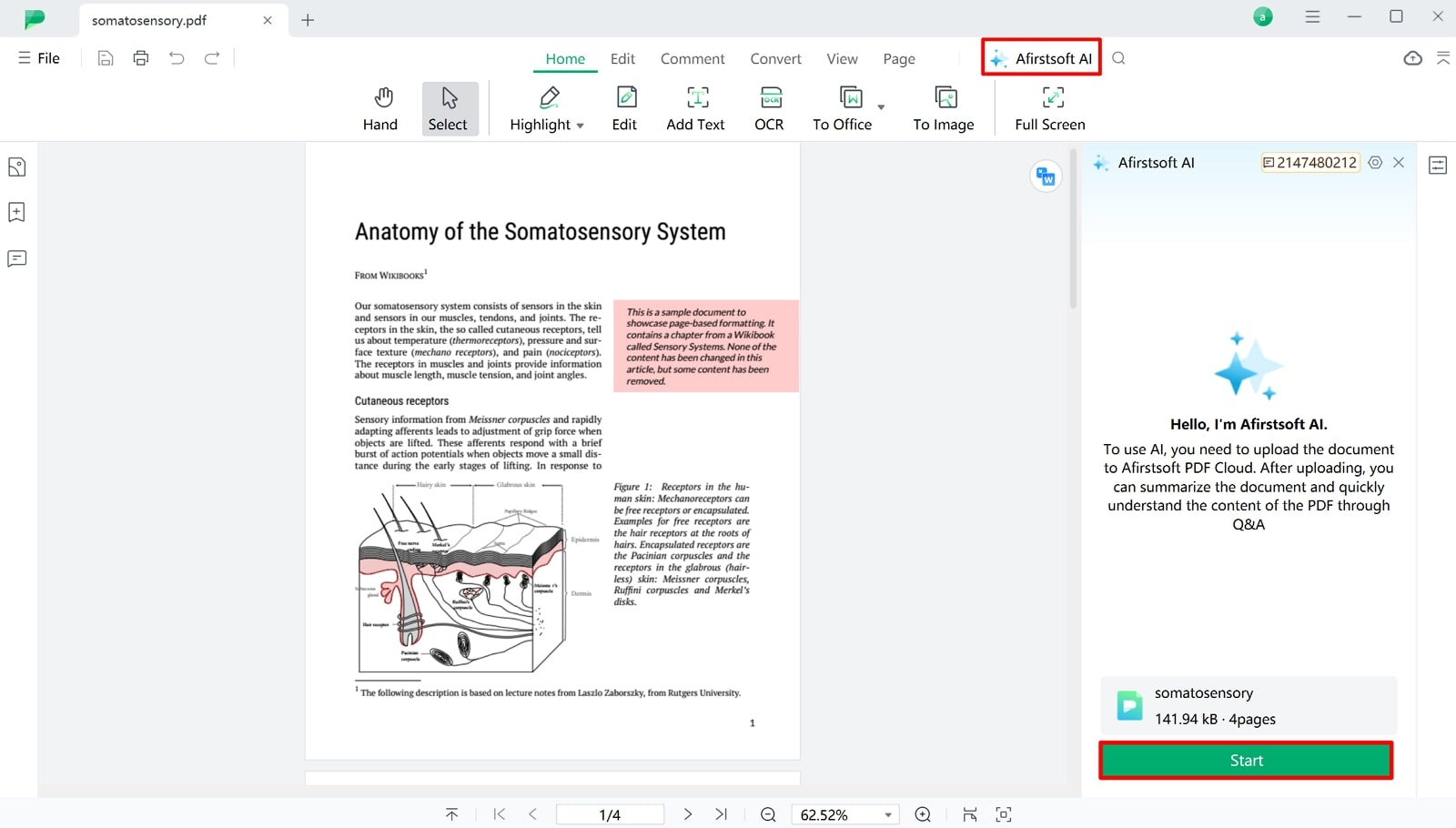
Step 3. Further Interact With AI Using the AI Chat Feature
After using the “Start” button, you will find a precise summary of your research article. You can further interact with AI using the text box bar at the bottom of the panel and learn complex concepts in the article summary.
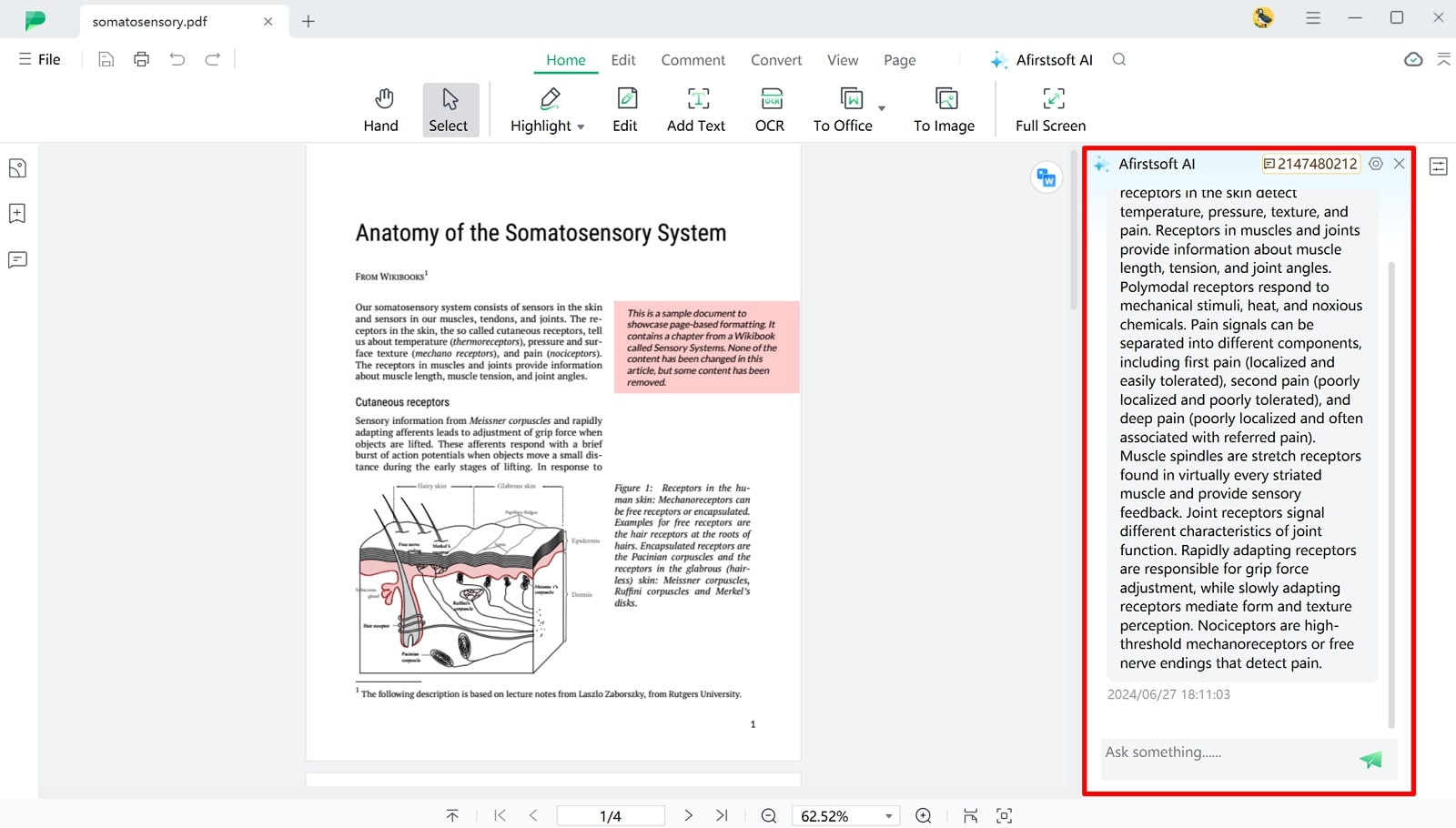
Part 4. Top 10 AI Tools for Summarizing Research Articles
Apart from the steps to manually summarize research articles, let’s discuss other routes to summarizing your research articles through AI research article summarization tools. Below are the top 10 AI tools utilized by researchers to summarize articles in an accurate and efficient manner:
1. ChatPDF
ChatPDF is an advanced AI tool designed to summarize extensive data into concise text. Researchers can use this tool to get instant answers to their questions and better understand research articles through AI.
Moreover, you can save their chat history by signing in, allowing them to stay organized and save prior summaries of research articles generated. Using this top AI summarization software, you can also search for keywords from the PDF document instead of reading the entire article.
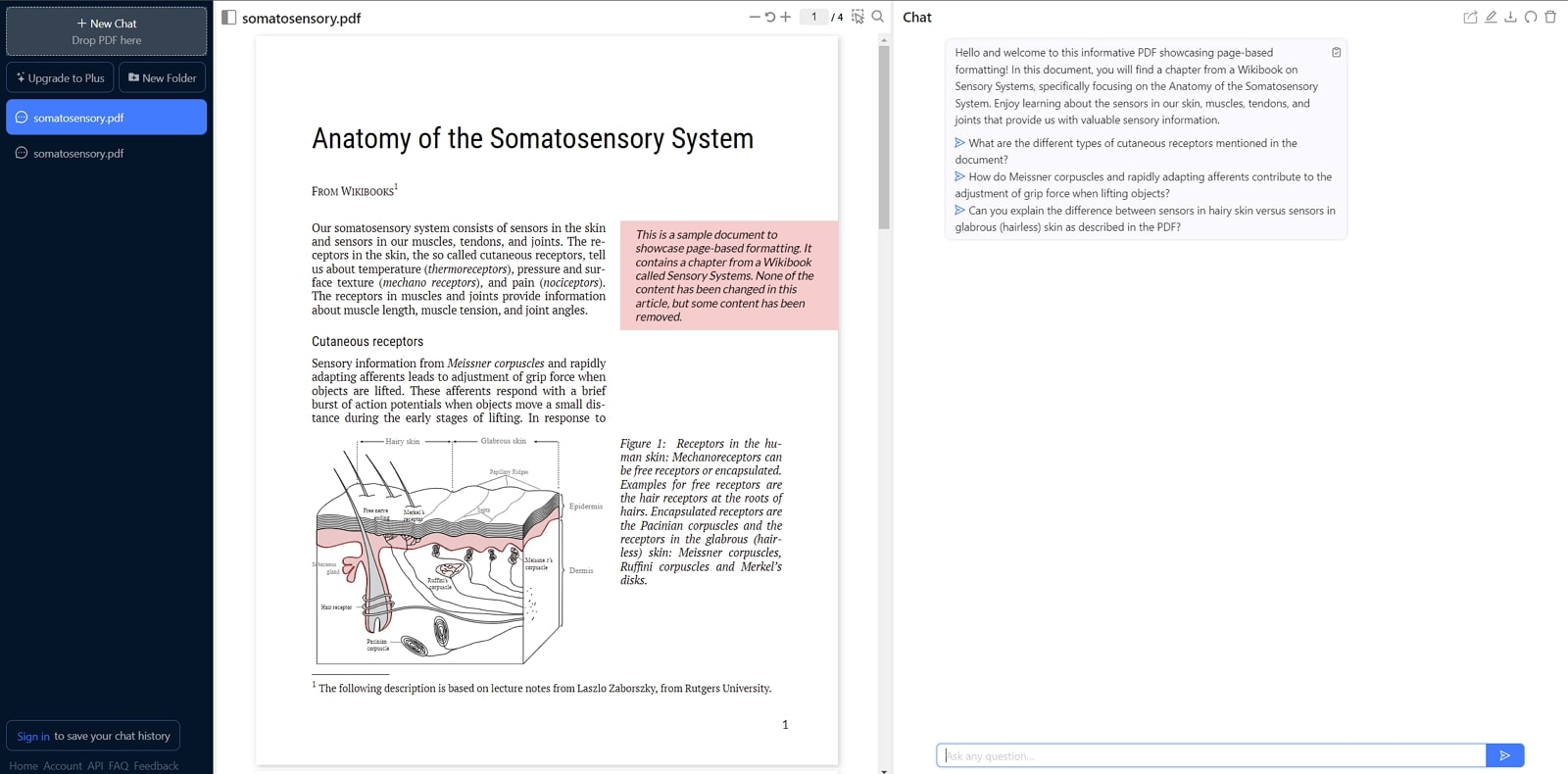
Features
- ChatPDF allows users to upload and translate their articles into any language they want.
- Users can create folders to organize their files and chat with multiple PDFs at a time.
- The answers generated contain references from the original research article so that you don't have to flip through multiple pages to find the source.
Pros
- Auto-generated questions will help you better understand the research article.
- Highlighting text on the original PDF document gives you a quick pop-up menu to summarize, explain, or rewrite content.
Cons
- Research articles larger than 32 MB cannot be uploaded and analyzed using the free version.
Pricing
- ChatPDF Plus: $9.99 per month
Supported Platforms
Online
2. Wondershare PDFelement
By utilizing the top AI summarization software, users can concisely research articles for a better understanding of data. While generating content from your large research articles, you can adjust output language, tone, and industry settings to set a standard for your summary.
Users can add customized summary prompts to generate more unique and standardized responses. Moreover, its AI PDF translator tool helps translate PDF documents into any language that suits your preferences.
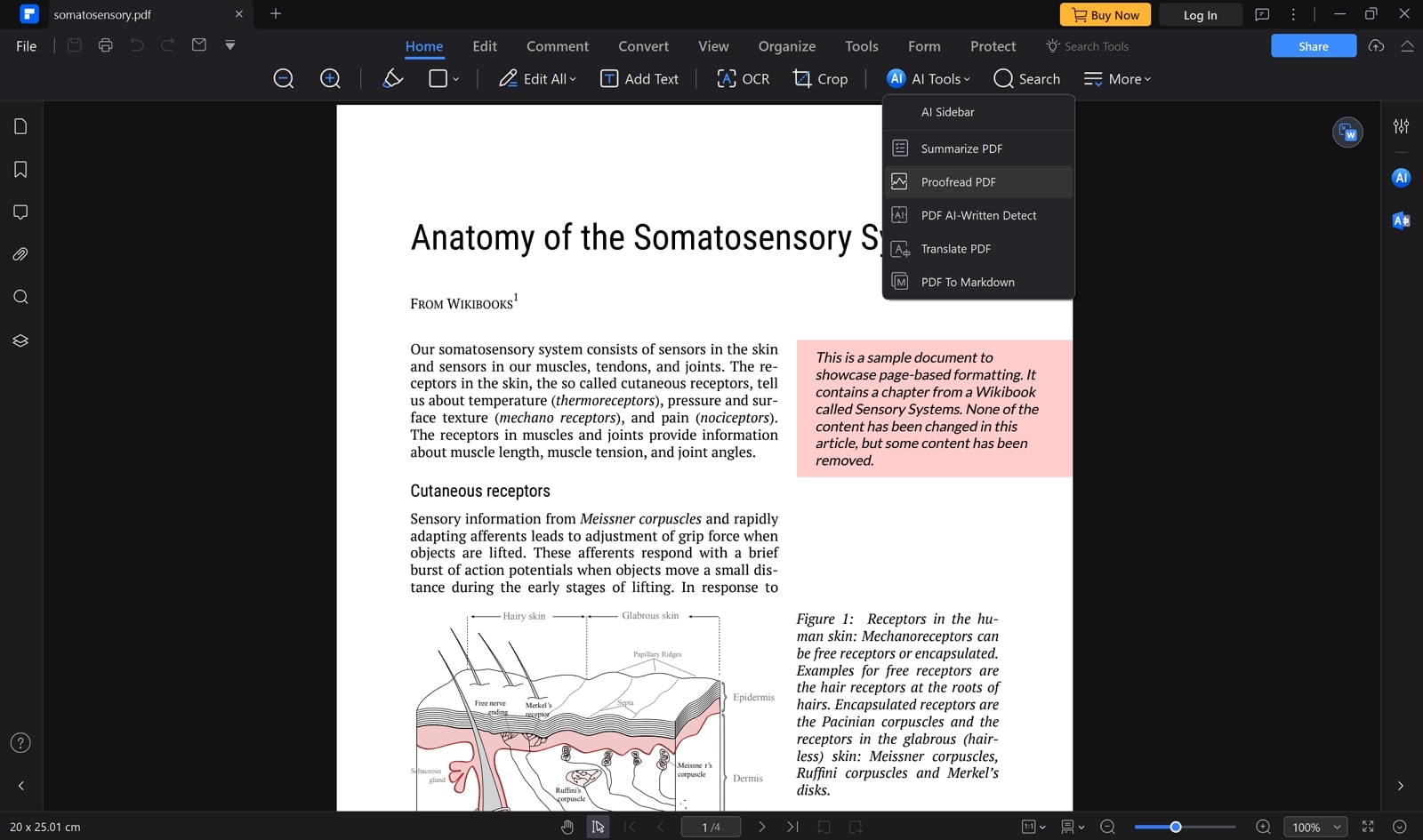
Features
- Wondershare PDFelement supports 13 languages to support its diverse audience who want to summarize their documents.
- Using this tool, researchers can upload any format they want as a PDF file before summarizing it with AI.
- Users can utilize the feature of AI rewriting PDF to enhance their original PDF of research articles.
Pros
- Once you install the application, you can save a lot of your time as there is no waiting required each time you summarize a PDF.
- PDFelement is more than a PDF summarizer, as you can build mind maps and proofread the document with this tool.
Cons
- A limited set of pages is allowed to be uploaded for users who are using the free version.
Pricing
- PDFelement AI Plan:$9.9 per month
- Quarterly Plan: $29.99
- Yearly Plan:$79.99
- Perpetual Plan:$129.99
Supported Platforms
Android, iOS, Windows and Mac
3. Scholarcy
When utilizing Scholarcy, researchers can benefit from summarizing extensive research articles into concise data. This efficient AI summarizer for research articles can summarize various documents, from book chapters to online articles, within seconds. Users can also export flashcards of the research article, which will help them understand the article better. Furthermore, it allows users to change the summary-generated view to a compact or individual section version.
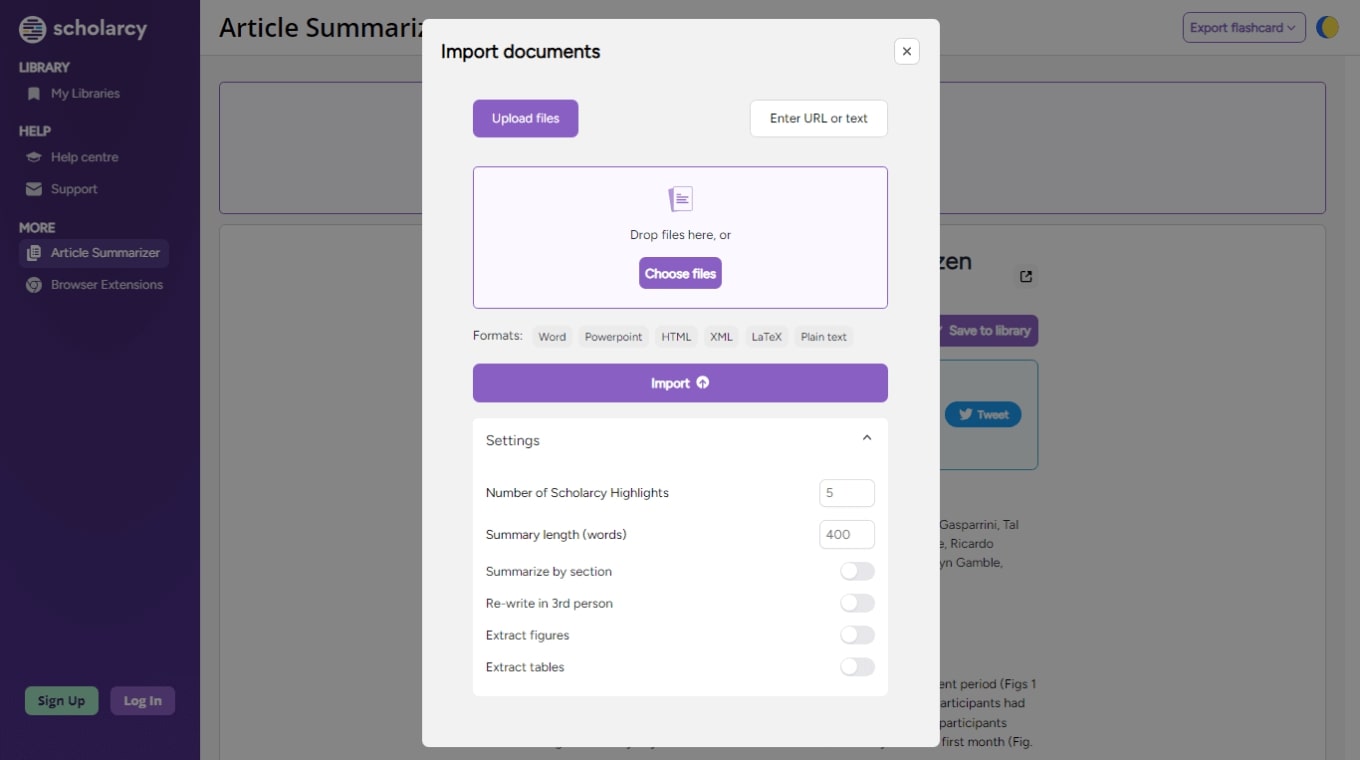
Features
- Scholarcy helps researchers download and export hyperlinked references to your reference manager.
- The summary generated can be exported as a Word, Markdown, or PowerPoint document.
- It suggests a background reading list that researchers can refer to in order to understand the main topics of the latest research.
Pros
- It extracts all numerical figures from the research article and links them to their cited location.
- Scholarcy’s unique Robo highlight automatically highlights all the essential elements present within the research article.
Cons
- Users who are using the free plan are limited to only generating 3 summaries per day.
Pricing
- Scholarcy Plus: $4.99 per month
Supported Platforms
Online Browser Extension
4. Unriddle
Unriddle allows users to generate summaries and export the files in a text format so they can be read offline. Accurate research article summaries generated through this tool are created from researchers' own data sources.
Through the tool's AI chatbot settings, users can change the AI model used to create responses. Apart from the summarizing tools, users can ask the AI chatbot to rewrite information from the PDF research article as well.
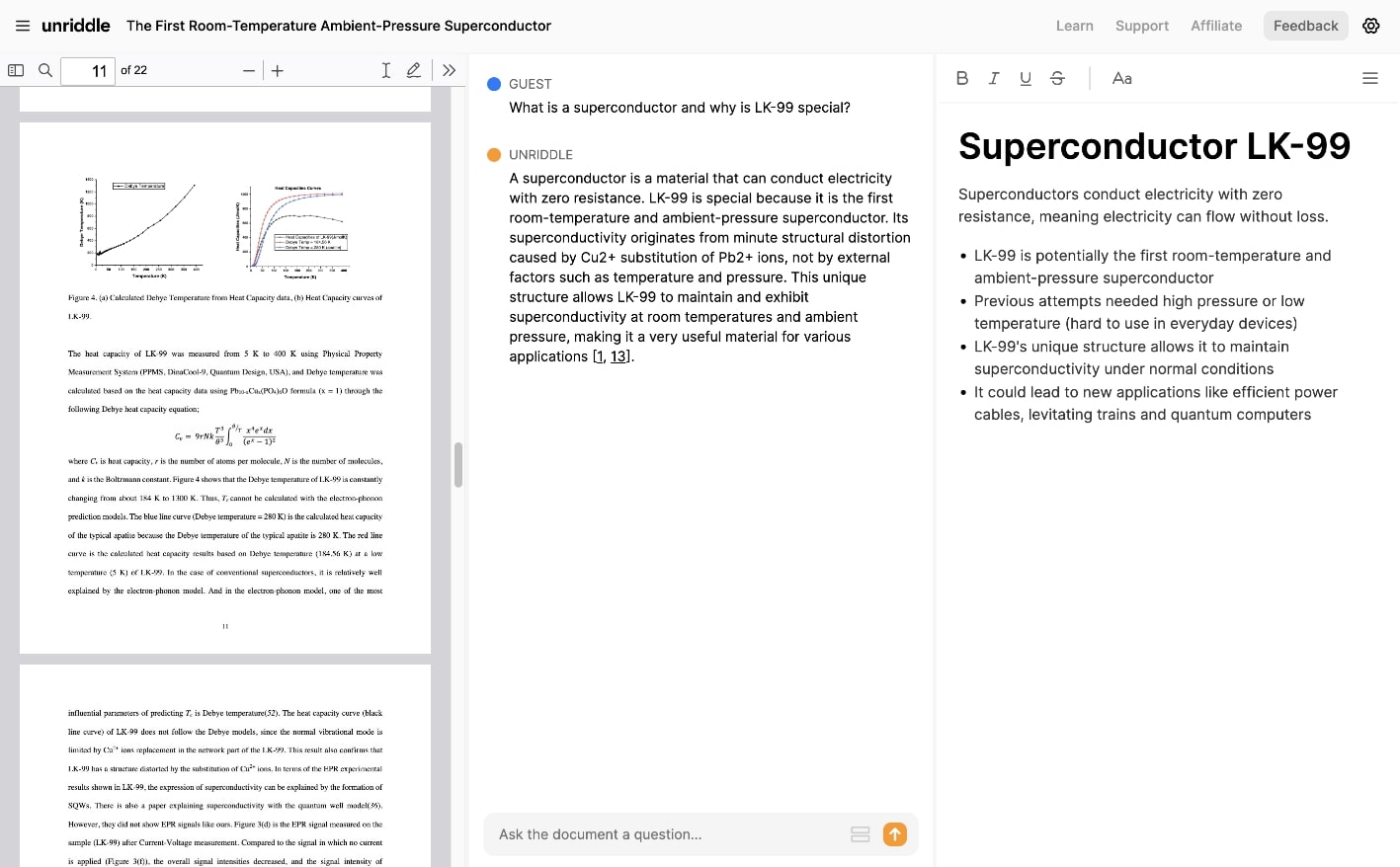
Features
- Users can read their research articles in preview mode for a quick skimming while generating summaries.
- Automated questions are generated through this AI tool to allow users to understand the research article in-depth without reading the document.
- With Unriddle, users can add side notes while working on the PDF summarization process.
Pros
- Citations of relevant sections pop up on the summarized content for reference purposes.
- Users can use Unriddle to translate their research articles into multiple languages.
Cons
- Users can only upload 5 PDFs per month if they are using the unpaid version of Unriddle.
Pricing
- Pro:$20 per month
- Premium:$30 per month
- Team:$150 per month
Supported Platforms
Online Web Extension
5. PDFgear
When talking about the top AI summarization software, PDFgear also stands out with its advanced AI chatbot. You can utilize this AI-powered PDF manager to interact with a range of documents, including books, essays, and academic papers.
While reading the PDF files, you can ask its AI assistant to analyze the content and provide you with accurate summaries. Other than that, this tool even lets you translate the generated AI content for global usability.
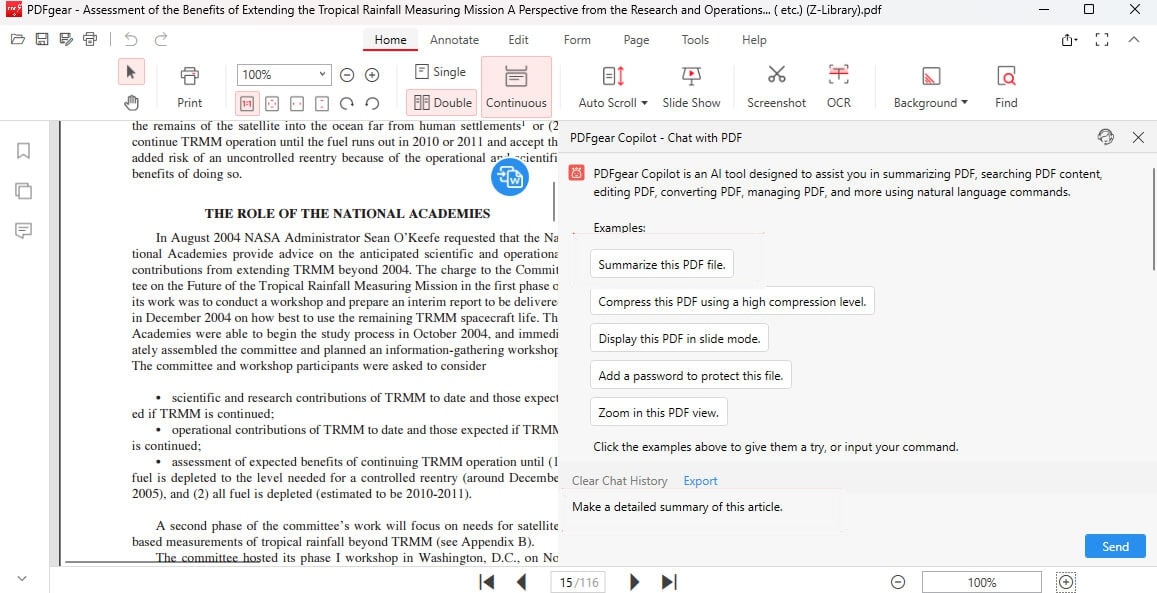
Features
- This AI chatbot generates 3 automatic PDF-related questions to help you learn more about the research article.
- Researchers can even ask for anything related to the uploaded article for improved comprehension.
- Using its AI Copilot, you can also ease out the document management processes, such as editing and conversion.
Pros
- Users can simply ask its AI chatbot to rewrite the content present within academic papers.
- The tool is entirely free to use for Windows, Mac, and iOS users.
Cons
- You will not be able to access this AI article summarization tool on Android.
Pricing
Free
Supported Platforms
Mac, Windows, iOS
6. HIX.AI
HIX.AI is an advanced online AI research article summarization tool that gives you the ability to generate summaries in multiple formats. While developing a summary, you can select paragraph or bullet point settings to get the desired output. In addition, users have the option to add the URL link of the research article to generate a quick summary without needing to save the academic paper.
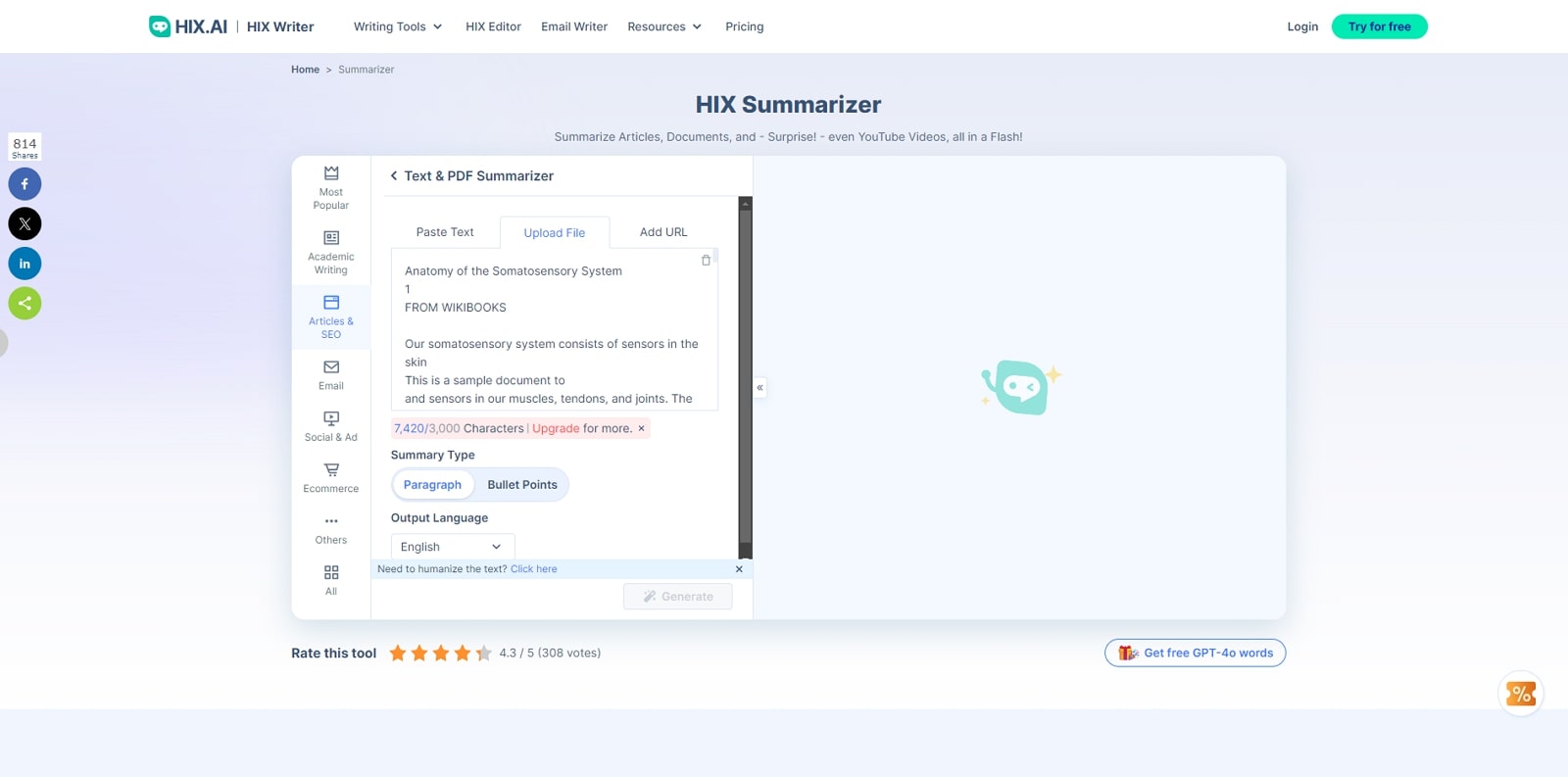
Features
- It provides access to the settings to adjust the language of the output summary.
- Other than creating a summary, you can chat with uploaded articles to reveal more insights.
- Using its paid version, generate unlimited AI content for easier article writing.
Pros
- AI also has a grammar checker to help you improve the content of your articles.
- This globally accessible tool supports over 30 languages while summarizing documents.
Cons
- There is a limitation of 3000 characters while summarizing articles using the free version.
Pricing
- Basic:$12.99 per month
- Pro:$19.99 per month
- Unlimited:$69.99 per month
Supported Platforms
Online
7. AskYourPDF
Powered by ChatGPT, this tool allows you to interact with your PDF research articles for better content consumption. With this tool, you can upload any file format, add a URL to your file, or import from Zotero to summarize the content.
Apart from summarizing text, this tool also looks into the visuals of the research article by explaining the images in the document. This top AI summarization software allows users to translate the original research PDF document into any language they want.
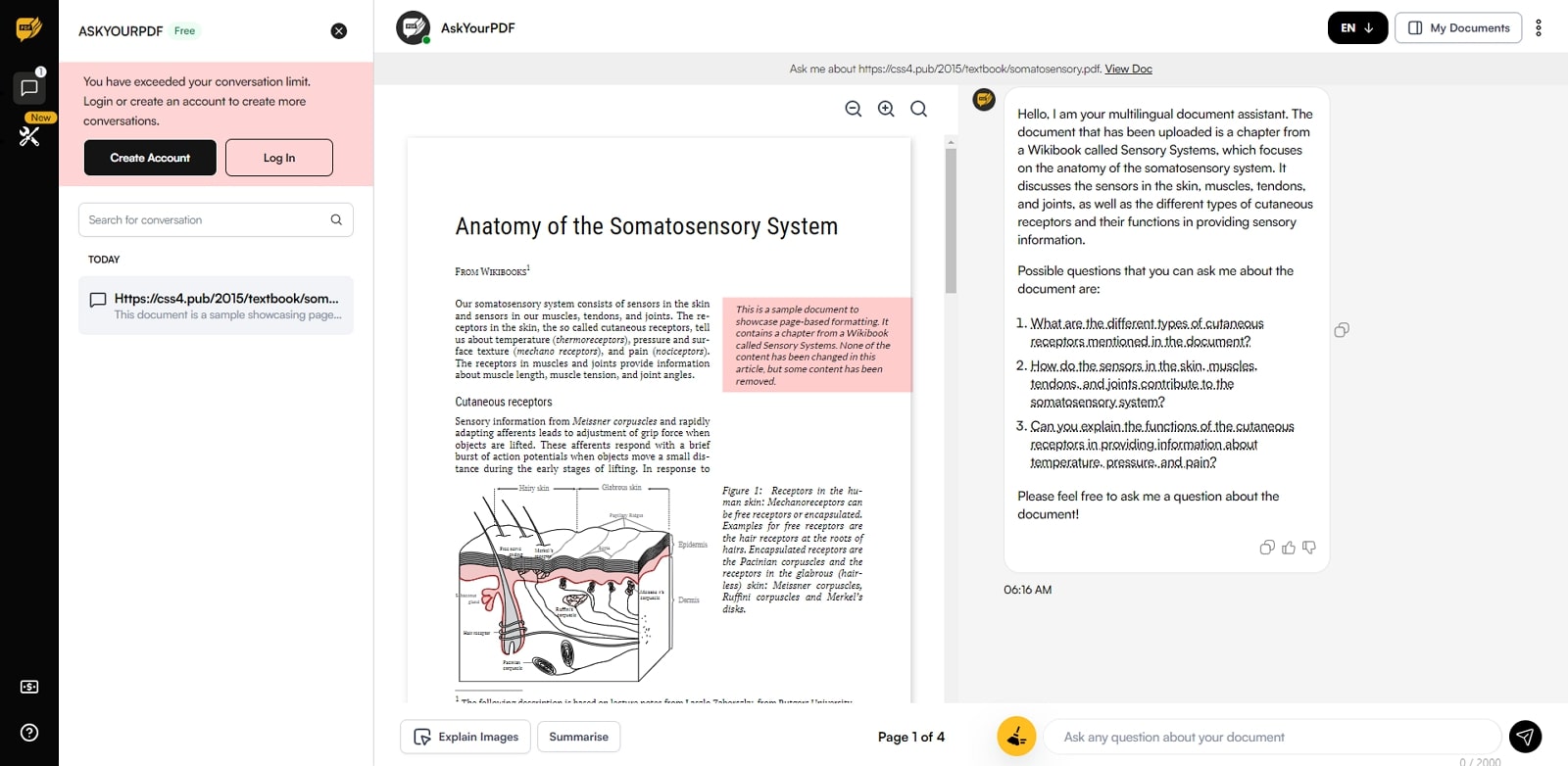
Features
- Users can upload multiple research articles to interact with them for quick understanding.
- When users highlight text within the PDF, a pop-up menu arises from where users can explain or rewrite the selected text.
- You can share your chat with AskYourPDF through different social media platforms or links.
Pros
- Users can effortlessly categorize PDFs into well-structured knowledge bases, allowing them to interact with multiple documents.
- Researchers have the ability to compare multiple PDFs side-by-side for a comprehensive analysis.
Cons
- Users are limited to only the GPT-3.5 model of ChatGPT while using the free version.
Pricing
- Premium: $14.99 per month
- Pro:$19.99 per month
Supported Platforms
Online, Browser Extension, Android, iOS
8. Adobe Acrobat AI Assistant
With the help of this efficient AI summarizer for research articles, users can extract valuable information from PDFs within a few clicks. Other than creating summaries, this tool allows you to access three content-related questions for better article content comprehension. Moreover, you also get the ability to ask questions from its AI assistant to understand each and every aspect of the academic papers.

Features
- Using its one-click summary feature, users can extract critical points within a few seconds.
- While using the mobile app, you get the chance to interact with the AI assistant through voice prompts.
- You can translate the generated summaries using this article summarizer for universal understanding.
Pros
- Researchers can brainstorm and generate content using prompts with the help of its AI Assistant.
- Users working with teams can automatically generate meeting summaries and identify action points from transcripts.
Cons
- The cost of this AI tool can be high for students looking to summarize research articles.
Pricing
- Acrobat Standard: $12.99 per month
- Acrobat Pro: $19.99 per month
- AI Assistant Add-on:$4.99 per month
Supported Platforms
Android, iOS, Windows, Mac
9. Sharly AI Summarizer
Sharly AI summarizes the complex data of your research articles into actionable insights. It gives its users a comprehensive analysis and literature review for better academic understanding.
AI research article summarization tools like Sharly empower researchers to extract relevant information and analyze data from various resources to speed up the research process. Moreover, it prioritizes data security and confidentiality, which is a crucial step in research environments.
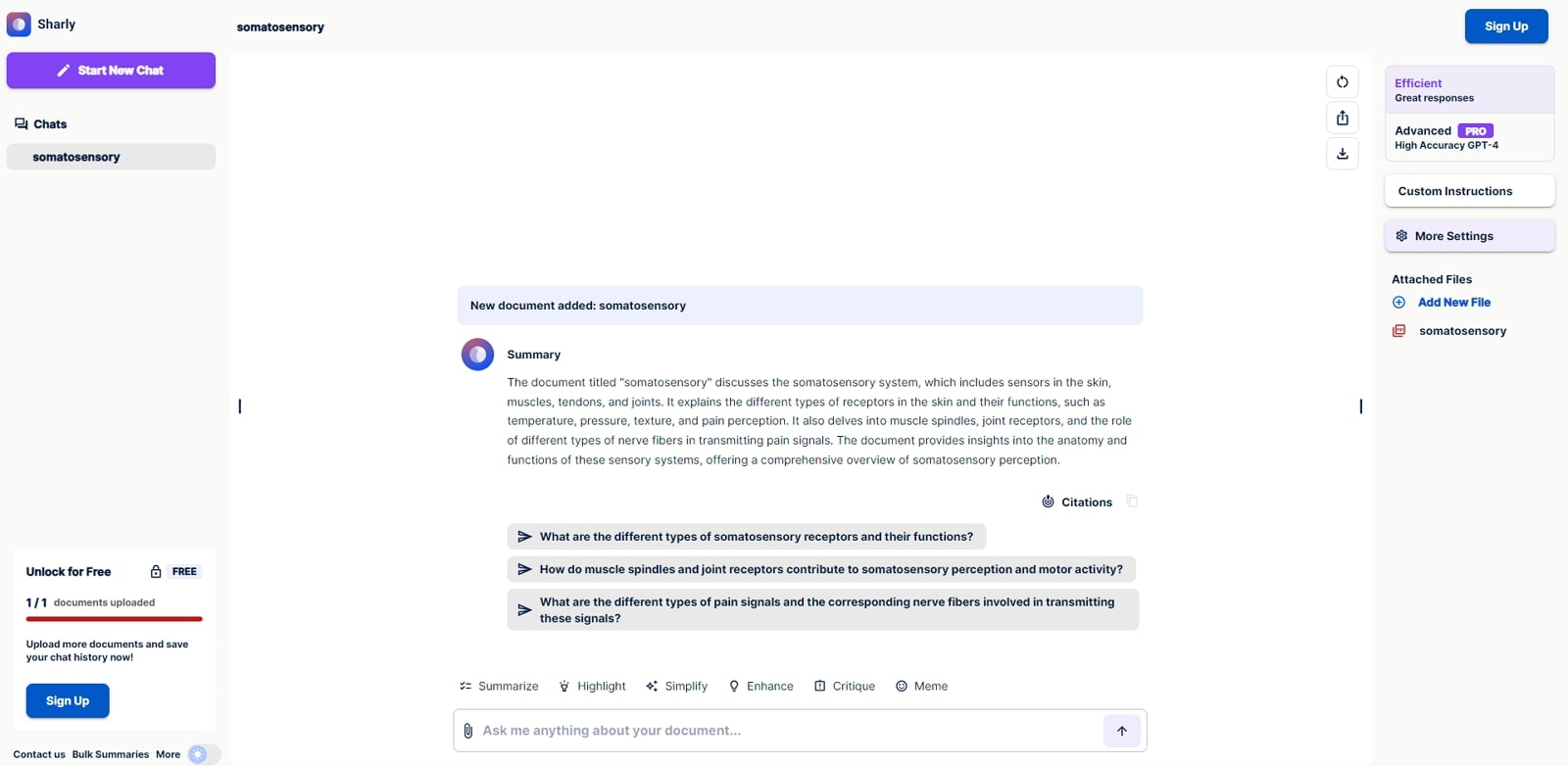
Features
- Users of Sharly have the ability to chat with PDFs and docs in over twenty or more languages.
- You get the ability to generate key points in a meme style to give a touch of humor to your articles.
- Using this tool, researchers can critique their content in a single click.
Pros
- Users also get the chance to simplify the content with the help of this AI tool.
- Sharly AI Summarizer supports different file formats, such as PDF with OCR, TXT, and DOC.
Cons
- Users can access the ChatGPT-4 model only if they upgrade to the professional version.
Pricing
- Professional:$15 per month
Supported Platforms
Online
10. QuillBot
When learning how to summarize a research article through AI tools, researchers prefer to utilize QuillBot. This AI tool allows users to summarize their content in different modes, such as paragraph or custom mode. Users can either paste the text they want to concisely or can upload the document. Apart from this, the researchers can adjust the summary length between short and long according to their desire.
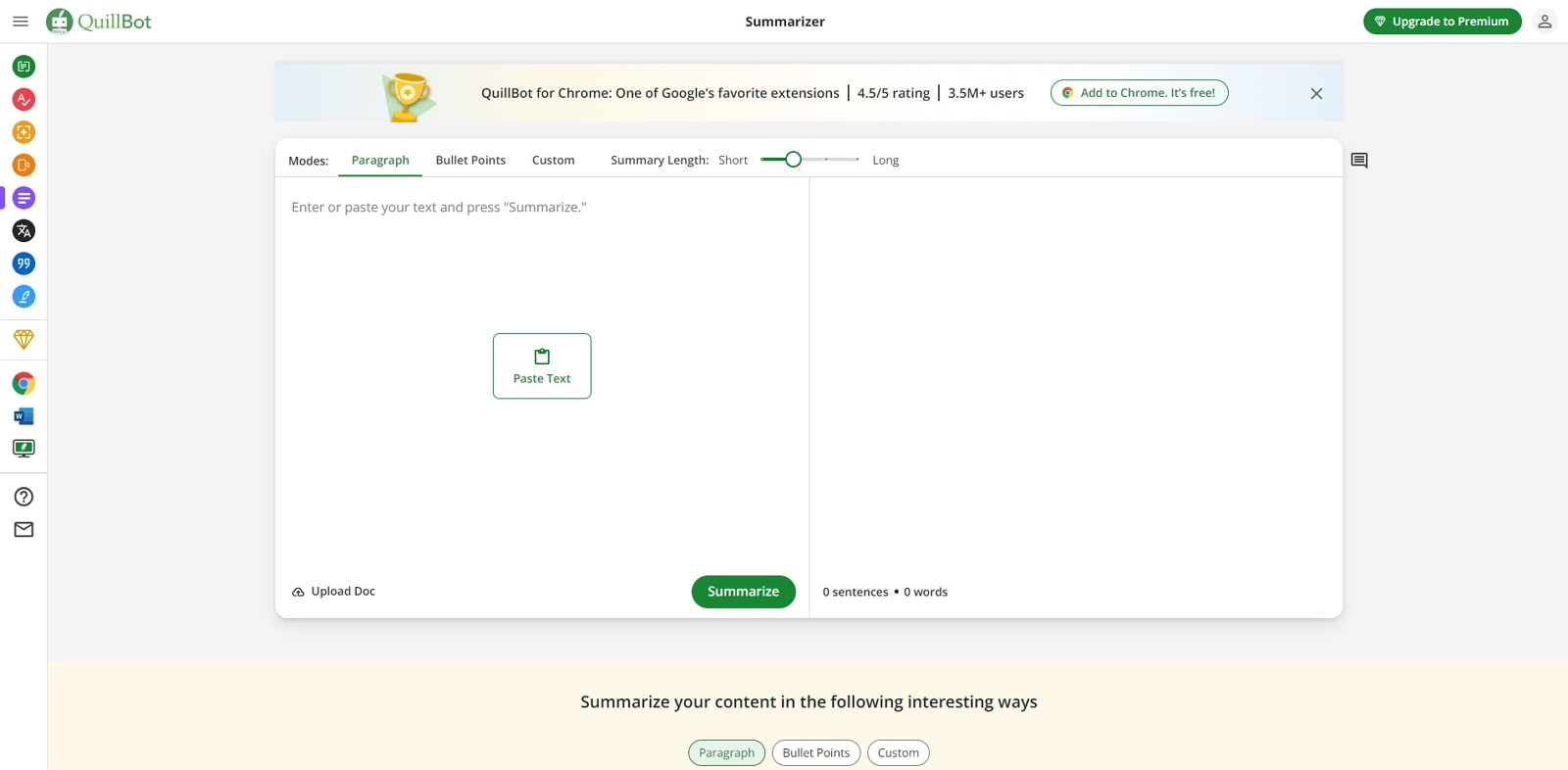
Features
- It offers various kinds of AI writing tools to work on after summarizing your document.
- Users can utilize this AI-powered tool to make their writing stand out by rephrasing the existing content in the research PDFs.
- You also get the ability to generate summaries in the form of bullet points using this tool.
Pros
- As an AI-powered tool, QuillBot quickly extracts vital points from long documents, allowing users to save time and effort.
- Allows various document formats and types, such as essays, papers, and more.
Cons
- For free users, there is a limit of 1,200 words only when summarizing content.
Pricing
- QuillBot Premium: $4.17 per month
Supported Platforms
Android, iOS, Windows, Mac, Web Extension
Part 5. Comparison of Top AI Summarization Tools
After going through all these best AI research article summarization tools, you must be wondering which one suits your needs the most. To make an informed decision, go through this comparison table comparing the functionality of all the tools side by side:
|
Metrics |
AI Article Summarizer |
Other AI Features |
Free Unlimited Access |
Secure |
User-Friendly Interface |
Rating |
|
Afirstsoft |
✓ |
Explain, Translate, Proofread, Rewrite, and more. |
✓ |
✓ |
✓ |
4.9 |
|
ChatPDF |
✓ |
Translate, Chat, AI Q&A |
X |
X |
✓ |
4.6 |
|
PDFelement |
✓ |
Detect AI Content, Rewriter, Proofread |
X |
✓ |
X |
4.7 |
|
Scholarcy |
✓ |
Extract Key Points, AI Flashcards |
X |
X |
✓ |
4.8 |
|
Unriddle |
✓ |
AI Questions, AI chatbot |
X |
✓ |
✓ |
4.6 |
|
PDFgear |
✓ |
Translate, Explain, AI Copilot |
✓ |
✓ |
X |
4.5 |
|
HIX.AI |
✓ |
AI Proofread, AI Content Writer |
X |
X |
✓ |
4.4 |
|
AskYourPDF |
✓ |
Interact with PDF, Explain Text |
X |
X |
✓ |
4.7 |
|
Adobe Acrobat AI Assistant |
✓ |
AI assistant |
X |
✓ |
X |
4.8 |
|
Sharly AI Summarizer |
✓ |
Simplify, AI Memes |
X |
X |
✓ |
4.5 |
|
QuillBot |
✓ |
AI Paraphraser |
X |
X |
✓ |
4.6 |
Once you analyze this table, it will become clear that the Afirstsoft PDF research summarizer is the best tool available in the market. In addition to summarization tasks, this tool allows you to translate and explain content with a single prompt. Most importantly, its free-of-cost features and easy-to-use interface make this AI tool superior to others.
Part 6. Tips for Effective Research Article Summarization With AI
Upon discussing all the top AI summarization software, you can now get familiarized with the best tips to get the best out of these tools. Go through each hack individually to learn how to generate the best outputs using these research article summarizers:
- Make Your PDF Articles Ready:Before carrying out the summarization process, you have to make sure that the PDF content is clean and well-structured. For this purpose, you can utilize reliable AI-powered OCR tools, such as Afirstsoft PDF, to convert PDF content to editable text.
- Use Advanced Techniques: You can implement advanced summarization techniques to enhance the quality of summaries. To do so, users should select critical sentences or phrases directly from the text to carry out the targeted summarization. Other than that, you can ask AI models to generate new sentences that capture the essence of the selected text.
- Utilize Specialized AI Models: Researchers shouldconsider using AI models trained specifically for summarizing scientific literature. These models can provide more accurate summaries that understand the complexities of research language and structure.
- Evaluate the Results:While finalizing the article summary, you should manually review each and every line to see if the summary is relevant and factually correct. In addition, users can provide feedback to the AI tool to get accurate research article summaries.
FAQs on AI Tools to Summarize Research Articles
- Can AI summarization tools handle multilingual research articles?
Many AI tools, such as Afirstsoft PDF research summarizer, support multilingual summarization for students globally. However, the quality may vary depending on the language and the availability of training data. Other than that, you can generate summaries in any of your desired languages with these AI-powered tools.
- How do we ensure the quality of the summaries generated by AI tools?
To ensure the quality of summaries generated by AI tools, you need to clean and structure the text properly before summarization. Other than that, we recommend you manually review and edit the summary for clarity and accuracy. For the best result, researchers should utilize AI tools specifically to summarize academic papers.
- What are the main types of summarization techniques?
When talking about the type of techniques, extractive summarization selects and extracts key sentences or phrases directly from the text. On the other hand, abstractive summarization generates new sentences that convey the main ideas of the text in a more concise manner. Alternatively, the hybrid type combines extractive and abstractive methods to form accurate research article summaries.
Conclusion
Throughout this article, you have explored efficient AI summarizers for research articles for better content consumption. Before explaining how to summarize a research article, we also familiarize you with the different components of research articles for your convenience.
Among the best PDF summarizers, Afirstsoft AI stands out as the best option with its advanced AI capabilities. In addition to summarizing research papers, this tool is capable of translating and explaining content.
